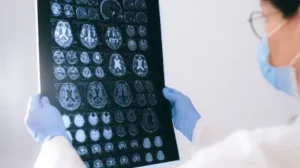As a young researcher in 2010, Dr. Mingshan Xue met Caroline DeLuca and her mother, Elizabeth. During their 20-minute talk, Caroline had three seizures — unfortunately frequent occurrences due to a mutation in one of her STXBP1 genes.
It made a lasting impression. When Xue established his lab in 2014 at Baylor College of Medicine to study the visual cortex, he established a side project investigating STXBP1, a mutation of which is very rare but is nonetheless considered one of the most common genetic causes of epilepsy [1].
“The only reason we started working on this is simply because I had met [Caroline], and I wanted to help,” Xue says. “I just thought I would do a small project to see what we could do about it.”
Ten years later that humble side project, with the help of funding from CURE Epilepsy, has developed into a potential curative treatment on the cusp of human clinical trials. Xue is now partnering with Capsida, a biotech company, to develop a gene therapy, CAP-002, that will supplement STXBP1 protein in the brain.
CAP-002 and therapies like it build on steady advances in genetics over the past two decades that include identifying the culprits behind hundreds of epilepsies. Identifying a gene implicated in epilepsy is powerful because it provides an explanation for someone’s seizures, and because it points the way to future treatments. For example, in STXBP1 disorders, the damaged STXBP1 gene reduces the amount of the STXBP1 protein, which is crucial for communication between neurons. If gene therapy could return a working copy of the STXBP1 gene to enough cells in the brain, this could compensate for the damaged gene, and potentially alleviate symptoms like seizures.
Stepping stones to gene therapies
Gene therapy for STXBP1-related disorders became a real possibility as a result of Xue’s research. He and his team first developed an animal model of STXBP1-related disorders by engineering mice to lack a copy of STXBP1. Similar to people with this condition, the mice developed movement impairments, cognitive deficits, and seizures [2].
Crucially, funding from CURE Epilepsy allowed Xue to test whether these symptoms could be reversed in adulthood. Are the consequences for a brain with a damaged gene onboard permanent, or are they reversible?
In 2019, Xue determined that the symptoms are, in fact, reversible in mice. When his team added back a working STXBP1 gene to the brain in adult mice, their symptoms were reduced, including the seizures. This proof-of-concept result indicated that a gene therapy could help people who had lived for years with STXBP1-related disorders.
If we were not able to do the genetic reversal experiment with the CURE Epilepsy funding, we would not even have the idea or courage to develop gene therapy.
CURE Epilepsy Grantee and Associate Professor at Baylor College of Medicine

Because it is challenging to deliver genes into all brain cells for gene therapy, particularly in large human brains, Xue’s team has also been investigating which cell types are the most important to target. In a recent publication they found that inhibitory neurons known to clamp down on electrical activity are important for most of the symptoms observed in the STXBP1-lacking mice [3].
In his current collaboration with Capsida, Xue is working to develop an efficient, non-toxic method of getting a replacement STXBP1 gene into enough cells in human brains. This involves a harmless type of virus that can be loaded with genetic cargo, then introduced to the brain to deliver the gene. Capsida and Xue are currently doing experiments to determine optimal dosage, while minimizing toxicity to organs like the liver. The results may well convince the FDA to allow the STXBP1 gene therapy to move to clinical trials sometime in 2025.
Supporting foundational research towards gene therapy for other rare epilepsies
CURE Epilepsy also promotes research for other rare epilepsies, particularly through its Rare Epilepsy Partnership Award. With this award, CURE Epilepsy collaborates with rare epilepsy advocacy groups to fund foundational research that is needed to better understand rare epilepsies and move towards the goal of developing genetic therapies. Rare Epilepsy Network (REN) Director Ilene Penn Miller shared, “CURE’s Rare Epilepsy Partnership Award was born out of recognition that many emerging organizations need access to both funding and mentoring. This grant mechanism has helped fund the development of critical research infrastructure tools for many REN members helping them accelerate their learnings and drive new therapies. It also provides organizations with research roadmapping and strategic planning partnership.”
Breakthroughs in any of the key areas below can positively affect gene therapy development across the rare and genetic epilepsies:
- Developing animal models to test potential genetic therapies As discussed with the STXBP1 work, animal models cannot mimic every aspect of a human condition. However, mouse experiments can help determine whether a brain is permanently changed by a genetic anomaly, or whether it retains the capacity to change when the genetic anomaly is corrected. In partnership with the Dup15q Alliance, CURE Epilepsy is funding Dr. Ype Elgersma at Erasmus to develop a new mouse model of Dup15q syndrome, which results in intractable epilepsy. His model allows investigation of why duplicating part of chromosome 15 leads to seizures, and it provides a tool to study whether these symptoms are reversible.
- Testing the efficacy of gene replacement in an animal model of the disease In partnership with SLC6A1 Connect, CURE Epilepsy is funding Dr. Hing Lee’s proof-of-concept study on gene replacement in SLC6A1 epileptic encephalopathy in an animal model. The study will test whether delivering normal copies of SLC6A1 in just the right amounts and to specific cells in the brain can reverse symptoms associated with this form of epilepsy.
- Understanding the natural history of rare epilepsies A natural history study can comprehensively describe how symptoms progress over time and provide a baseline for understanding and evaluating potential genetic therapies. CURE Epilepsy partnered with The Cute Syndrome Foundation to fund Dr. Jillian McKee’s work at Children’s Hospital of Philadelphia which aims to better understand the full range of clinical features in people with SCN8A-related epilepsy.
As these lines of gene therapy research continue to advance, CURE Epilepsy remains focused on funding rare and genetic epilepsies more broadly as well, dating back to its Epilepsy Genetics Initiative. CURE Epilepsy has also more recently initiated projects focused on epilepsy with eyelid myoclonia, also called Jeavons syndrome, and epileptic spasms. And by providing funding for the 2024 STXBP1 Researcher Roundtable meeting hosted by the STXBP1 Foundation, CURE Epilepsy was also able to help educate the STXBP1 community on the exciting commercial advances stemming from Dr. Xue’s initial grant and other STXBP1 research.
“CURE Epilepsy has provided funding to make this meeting happen, multiple times,” says Charlene Son Rigby, president and co-founder of the STXBP1 Foundation who also has an 11-year-old daughter with an STXBP1-related disorder. “We’re a very new, small non-profit and so their funding has been crucial.”
Progress continues
Unfortunately, all of this recent progress is too late to help Caroline DeLuca, who passed away in 2016. Yet part of her legacy is to have spurred Xue, who had not been trained to study epilepsy, to work on STXBP1-related disorders.
“I never worked on any epilepsy or neurodevelopmental disorder before, so I’m an outsider to this field. But I wanted to help, because it was such a rare disease that nobody wanted to study it.”
Dr. Mingshan Xue
CURE Epilepsy Grantee and Associate Professor at Baylor College of Medicine
As an umbrella organization promoting research for all epilepsies, CURE Epilepsy is committed to continuing to connect models and progress across rare and genetic epilepsies for the benefit of future patients.
This approach is appreciated by scientists and family advocates alike, including Son Rigby. “CURE Epilepsy is really a key and long-term driver of raising the visibility of the impact of epilepsy and the need to fund research in epilepsy,” she adds.
Literature Cited:
- Symonds JD, McTague A. Epilepsy and developmental disorders: Next generation sequencing in the clinic. Eur J Paediatr Neurol. 2020 Jan;24:15-23.
- Chen W, Cai ZL, Chao ES, Chen H, Longley CM, Hao S, et al. Stxbp1/Munc18-1 haploinsufficiency impairs inhibition and mediates key neurological features of STXBP1 encephalopathy ELife. 2020 Feb; 9:e48705.
- Kim JH, Chen W, Chao ES, Rivera A, Kaku HN, Jiang K, et al. GABAergic/Glycinergic and Glutamatergic Neurons Mediate Distinct Neurodevelopmental Phenotypes of STXBP1Encephalopathy. J Neurosci. 2024 Apr; 44:e1806232024









